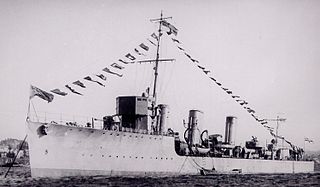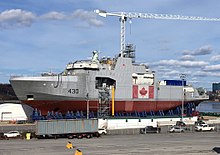
The Royal Canadian Navy is the naval force of Canada. The navy is one of three environmental commands within the Canadian Armed Forces. As of February 2024, the RCN operates 12 Halifax-class frigates, 12 Kingston-class coastal defence vessels, 4 Victoria-class submarines, 4 Harry DeWolf-class offshore patrol vessels, 8 Orca-class patrol vessels, and several auxiliary vessels. The RCN consists of 8,400 Regular Force and 4,100 Primary Reserve sailors, supported by 3,800 civilians. Vice-Admiral Angus Topshee is the commander of the Royal Canadian Navy and chief of the Naval Staff.
The history of the Royal Canadian Navy goes back to 1910, when the naval force was created as the Naval Service of Canada and renamed a year later by King George V. The Royal Canadian Navy (RCN) is one of the three environmental commands of the Canadian Forces. Over the course of its history, the RCN has played a role in the First World War, contributed significantly to the Battle of the Atlantic during the Second World War, and was a part of NATO's force buildup during the Cold War. In 1968, the RCN was amalgamated with the Canadian Army and the Royal Canadian Air Force to form what is today the unified Canadian Armed Forces. The naval force was known as Maritime Command until 2011, when the environmental command was renamed as the Royal Canadian Navy.

The Kingston class consists of 12 coastal defence vessels operated by the Royal Canadian Navy. The class is the name for the Maritime Coastal Defence Vessel Project (MCDV). These multi-role vessels were built and launched from the mid- to late-1990s and are crewed by a combination of Naval Reserve and Regular Force personnel. The main mission of the vessels is to train reservists, coastal patrol, minesweeping, law enforcement, pollution surveillance and search and rescue duties. The multi-purpose nature of the vessels led to their mixed construction between commercial and naval standards. The Kingston class is split between the east and west coasts of Canada and regularly deploy overseas to West Africa, Europe, Central America and the Caribbean.

The Orca-class patrol vessels are a class of eight steel-hulled training and surveillance vessels in service with the Royal Canadian Navy (RCN) at Patrol Craft Training Unit (PCTU) Canadian Forces Base (CFB) Esquimalt. Based on the Australian Pacific-class patrol boat design, all of the Orca vessels were constructed by Victoria Shipyards between November 2004 and November 2008. In addition to carrying the RCN designation of patrol craft training (PCT), the Orca class are not formally commissioned in the RCN and as such do not possess the His Majesty's Canadian Ship (HMCS) prefix.

Canadian Forces Base Esquimalt is Canada's Pacific Coast naval base and home port to Maritime Forces Pacific and Joint Task Force Pacific Headquarters. As of 2018, 4,411 military personnel and 2,762 civilians work at CFB Esquimalt.

The Canadian Surface Combatant, formerly the Single Class Surface Combatant Project is the procurement project that will replace the Iroquois and Halifax-class warships with up to 15 new ships beginning in the mid to late 2020s as part of the National Shipbuilding Procurement Strategy.

YAG 300 vessels were a series of ten wooden boats built between 1954 and 1955 that throughout their service acted as yard ferries, training platforms and test beds for route survey equipment with the Royal Canadian Navy (RCN).

In the Canadian Armed Forces, Maritime Forces Pacific is responsible for the fleet training and operational readiness of the Royal Canadian Navy in the Pacific Ocean. It was once referred to as Canadian Pacific Station.
The Royal Canadian Navy uses hull classification symbols to identify the types of its ships, which are similar to the United States Navy's hull classification symbol system. The Royal Navy and some European and Commonwealth navies use a somewhat analogous system of pennant numbers.

HMS Patriot was a Thornycroft M-class destroyer that served in the British Royal Navy. The destroyer entered service in 1915 during the First World War and saw service with the Grand Fleet. Following the war, the destroyer was declared surplus and in 1920, the ship was transferred to the Royal Canadian Navy. Recommissioned as HMCS Patriot, the destroyer was used primarily as a training ship. Patriot was taken out of service in 1927, sold for scrap in 1929 and broken up.

The Canadian Patrol Frigate Project (CPFP) was a procurement project undertaken by the Department of National Defence of Canada beginning in 1975 to find a replacement for the 20 combined ships of the Annapolis, Mackenzie, Restigouche, and St. Laurent classes of destroyer escorts. The CPFP was considered a core effort in the fleet modernization of Canada in the 1980s. Facing several contract hurdles, the construction program got underway in 1987. The CPFP became known as the Halifax-class frigate upon the construction of the ships. The Halifax class replaced the destroyer escort classes in the 1990s and remains a core element of the fleet.

Harry DeWolf-class offshore patrol vessels are warships of the Royal Canadian Navy (RCN) built within the Government of Canada Arctic and Offshore Patrol Ship (AOPS) procurement project, part of the National Shipbuilding Strategy. In July 2007 the federal government announced plans for acquiring six to eight icebreaking warships for the RCN.

The Naval Reserve is the Primary Reserve component of the Royal Canadian Navy (RCN). The primary mission of the NAVRES is to force generate sailors and teams for Canadian Armed Forces (CAF) operations, including: domestic safety operations as well as security and defence missions, while at the same time supporting the Navy's efforts in connecting with Canadians through the maintenance of a broad national presence.

Irving Shipbuilding Inc. is a Canadian shipbuilder and in-service support provider.

HMCS Hunter is a Canadian Forces Naval Reserve Division (NRD) located in Windsor, Ontario. Dubbed a stone frigate, HMCS Hunter is a land-based naval training establishment crewed by part-time sailors and also serves as a local recruitment centre for the Canadian Forces Naval Reserve. It is one of 24 naval reserve divisions located in major cities across Canada.

Canadian Forces Auxiliary Vessel (CFAV) Caribou was one of ten wooden YAG-300 vessels built for the Royal Canadian Navy (RCN) between 1953 and 1955. Built for use as auxiliary craft, Caribou primarily served as an at-sea training platform for junior naval officers, boatswains, reserve personnel and Sea Cadets at Canadian Forces Base (CFB) Esquimalt.

Canadian Forces Auxiliary Vessel (CFAV) Grizzly was one of ten wooden YAG 300 vessels built for the Royal Canadian Navy (RCN) between 1953 and 1955. Built for use as auxiliary craft, Grizzly primarily served as an at-sea training platform for junior naval officers, boatswains, reserve personnel and Sea Cadets at Canadian Forces Base (CFB) Esquimalt. Her name perpetuated the WWII armed yacht HMCS Grizzly was reused for PTC 60 GrizzlyOrca-class Patrol Craft Training (PCT) tender that replaced the YAG 300 vessels as the RCN training tenders in 2008.

Canadian Forces Auxiliary Vessel (CFAV) Cougar was one of ten wooden YAG 300 vessels built for the Royal Canadian Navy (RCN) between 1953 and 1955. Built for use as auxiliary craft, Cougar primarily served as an at-sea training platform for junior naval officers, boatswains, reserve personnel and Sea Cadets at Canadian Forces Base (CFB) Esquimalt. Her name was reused for PTC 61 CougarOrca-class Patrol Craft Training (PCT) tender that replaced the YAG 300 vessels as the RCN training tenders in 2008.























